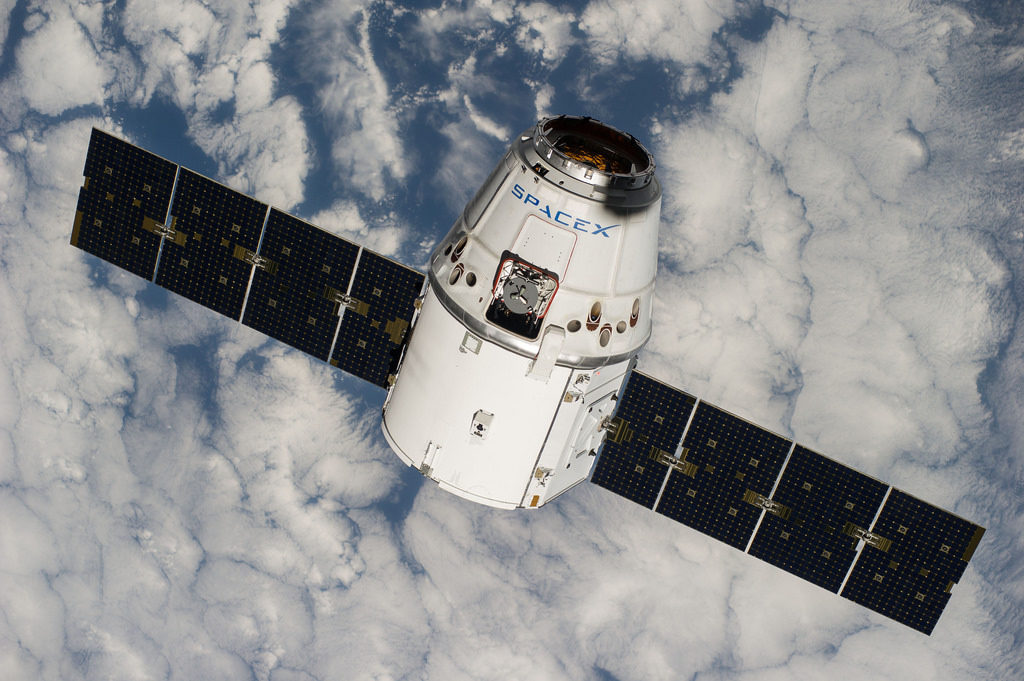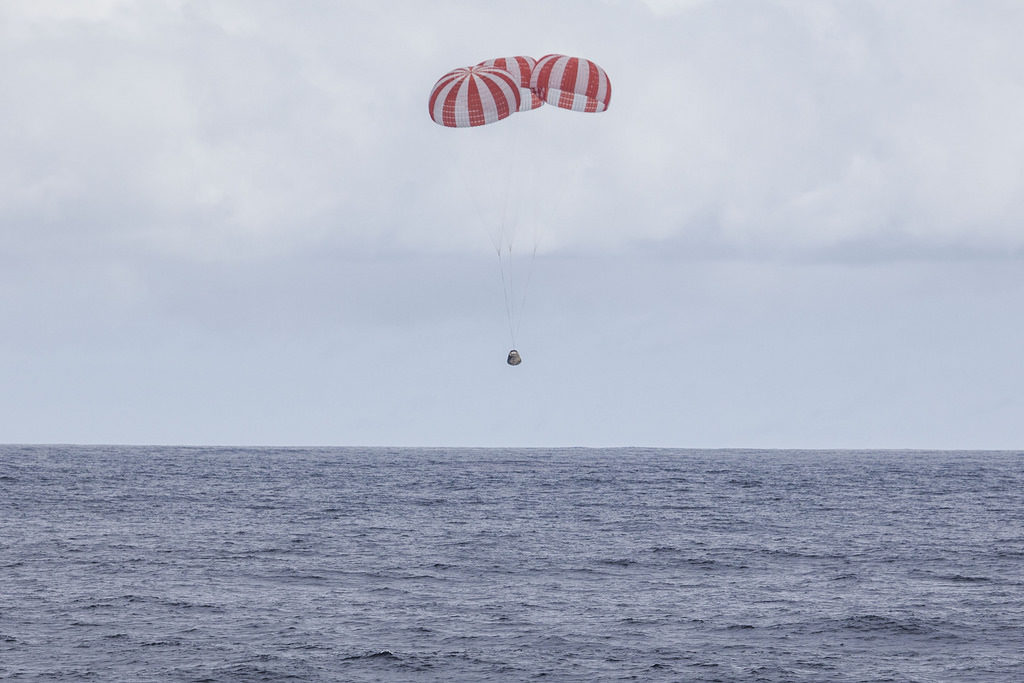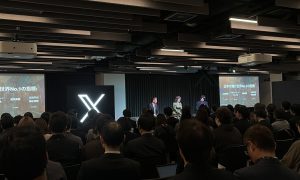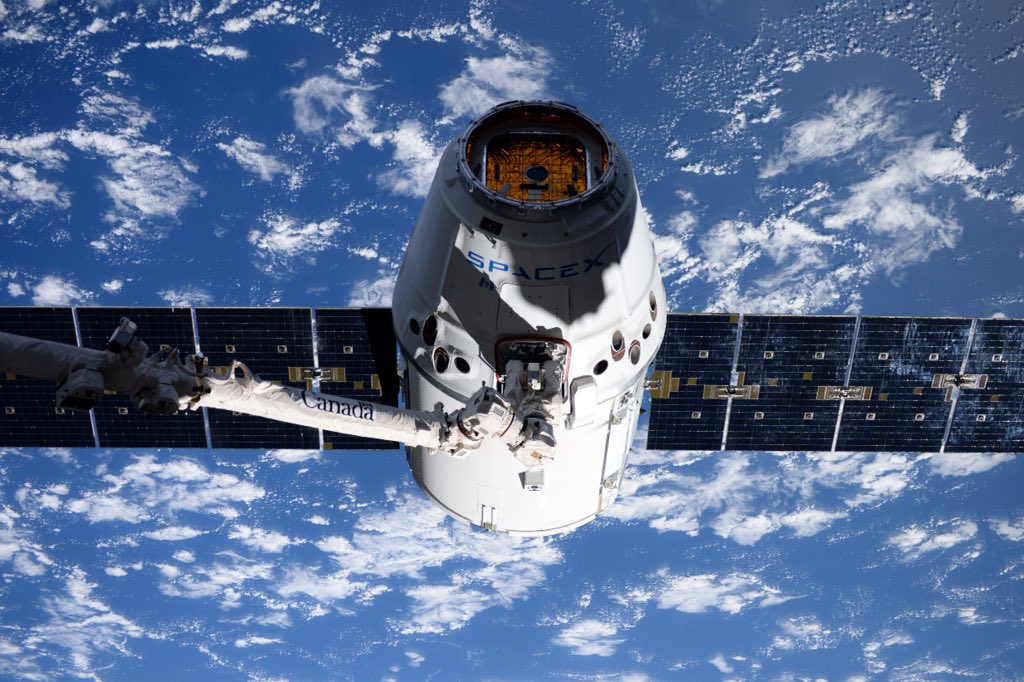

SpaceX
What SpaceX’s successful reuse of Dragon Spacecraft really means
Following Saturday’s auspicious launch and and first stage recovery, SpaceX’s Dragon spacecraft has successfully rendezvoused and docked with the International Space Station. Bringing with it more than 5,000 pounds of food, water, scientific experiments, and technology demonstrations, the company’s eleventh mission under their first Commercial Resupply Services contract is exceptional for a very unique and specific reason: the vehicle has flown before, bringing cargo to the ISS on SpaceX’s fourth CRS mission to the ISS. This accomplishment makes the Dragon currently docked at the ISS the only commercial spacecraft in human history to be launched into orbit more than once, continuing a tradition of auspicious firsts.
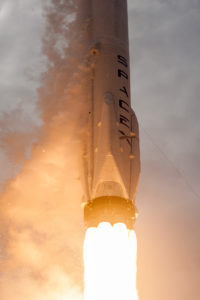
CRS-11 just after liftoff. Note the core designation “35” under the landing leg. (SpaceX)
Slightly more than two months after the first ever successful reuse of an orbital-class rocket, SpaceX now has two extraordinary demonstrations of success in favor of the company’s pursuit of democratizing affordable access to space. Reusability is and has been SpaceX’s method of pursuing that goal for at least a decade, with Musk publicly exhorting the potential benefits of rapid and complete reusability as early as 2007. It is almost a running joke within the community of aerospace and SpaceX fans that Musk will compare commercial airlines to orbital launch services at least once every time he is interviewed, but his point is and has long been clear. If all one has to do to run a transportation service is refuel after every trip, the price of a ticket or cargo transport drastically decreases. While many have slyly laughed or dismissed this goal in the past, often using the Space Shuttle as an example of the futility of reusability as a tool for cost reduction, it is quite hard to deny what SpaceX has accomplished so far.
The reuse of a Cargo Dragon is also arguably far more significant than it may initially appear. SpaceX has not provided any concrete information on the process of refurbishing the capsule, and it is entirely unclear if the “reuse” entailed much more than furnishing the CRS-4 pressure vessel and Draco thrusters with a new trunk, solar array, external shell. It is possible that, just like SES-10, the process of refurbishing a spacecraft for the first time resulted in little to no cost savings, and that this refurbishment took anywhere from several months to more than a year, with the CRS-4 capsule returning from orbit in late 2014. However, given the absolute rarity of reused capsule-type spacecraft, the data that engineers likely gathered throughout the process of refurbishing the Dragon would arguably make the whole process worthwhile even in the worst case scenarios described above. Hans Koenigsmann, Vice President of Mission Assurance at SpaceX, also noted in a press conference following CRS-11’s launch that the refurbishment of the capsule was somewhat uneventful, stating that the CRS-4 capsule had no unanticipated damage from the rigors of reentry and ocean landing and that SpaceX was already ready to consider using the capsule a third time. It’s likely that SpaceX will begin to rely more heavily on Cargo Dragon reuse as they refocus a majority of their manufacturing efforts on Dragon 2.
- The CRS-4 Dragon just before capture. (NASA)
- CRS-4 reentered in late 2014 and was recovered in the Pacific Ocean. (SpaceX)
SpaceX and Musk’s (in)famous ultimate ambitions are to make humanity a multiplanterary species, partly as a way to combat the extinction risks that an asteroid or comet strike pose, and partly because it is simply a staggering challenge that has the potential to make many humans “excited to wake up in the morning”. In order to make this happen, Musk saw that access to orbit was far too expensive for a colony on another planet to ever be sustainable, and that resuability was the only immediately obvious and accessible method through which the price to orbit could be decreased by several magnitudes. SpaceX is now almost routinely recovering Falcon 9 first stages when the mass of the payload allows it, and with a fifth and final version or “Block” of the vehicle optimized for rapid reuse set to debut later this year, Musk and others at the company have begun ruminating once more about the possibility of recovering and reusing the second stage of the Falcon 9. Benchmarked somewhere around 30% of the price of the vehicle, routine loss of the second stage effectively prevents the price of the Falcon 9 from dropping much below $20-30 million US dollars. While a nearly 50% or greater reduction in price would be an exceptional accomplishment, it is still far from from the multiple orders of magnitude reduction Musk hoped for when he set out to develop reusable rocketry.
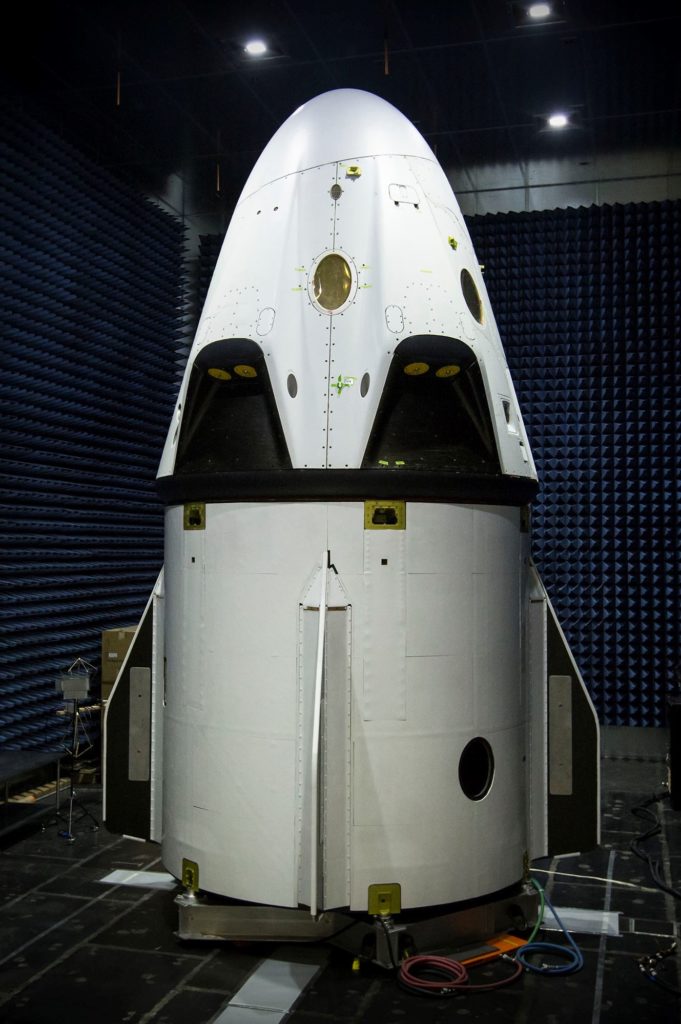
A prototype of Dragon 2 being tested in an anechoic chamber. (SpaceX)
This is where the reuse of Dragon pops its head up. With second stage recovery now being considered theoretically and Dragon 2 (Crew Dragon) preparing to begin regular launches in either Q4 2017 or Q1 2018, SpaceX has a good deal of experience to gain from learning how to safely and rapidly recover and reuse vehicles reentering the atmosphere at orbital velocity. Compared to recovering the first stage, this is another endeavor entirely. The fastest speed at which a recoverable first stage can ever realistically reenter the atmosphere is currently capped at around 5200 mph (2300 m/s), and is usually much closer to 3000 mph. An orbital capsule like Dragon, however, enters the atmosphere from Low Earth Orbit (LEO) at around five times that speed, typically close to 16,000 mph. In the context of recovering the second stage of Falcon 9, one must consider that most of SpaceX’s commercial manifest is made up of geostationary satellites, which require more energy to reach a higher orbit, and consequently would require the second stage to survive even higher reentry velocities in order to be recovered.
Returning from Mars, as SpaceX’s Interplanetary Transport System would have to, results in even higher reentry velocities of at least 25,000 mph for a reasonably quick journey. This is the most important detail in explaining the true value of simply reusing a Dragon capsule as SpaceX has just now done. By taking its first steps towards routinely reusing truly orbital spacecraft, SpaceX is advancing their knowledge reusability in practice and consequently taking concrete steps to prepare themselves for the difficult challenges that lie ahead in their pursuance of enabling sustainable colonization of Mars. Dragon 2 (Crew Dragon) promises to eventually rid the refurbishment process of the many headaches that salt water intrusion undoubtedly creates by returning via supersonic retropropulsion to a landing pad, much like Core 35 did this past Saturday.
Looking slightly further into the future, SpaceX has already announced plans to launch two unnamed private customers in a Dragon 2 on what would likely be a circumlunar free return trajectory, or around the Moon and back. The reentry velocity would be very similar to the velocity required to return to Earth from Mars, and certainly much faster than any reentry from geostationary orbits of Earth. If SpaceX manages to successfully and reliably recover and reuse orbital vehicles reentering at such high velocities, then the company will have made extraordinarily promising progress towards achieving their central goal of drastically lowering cost to orbit and thus enabling humanity to gain footholds on other planets.
So, take this Dragon reuse as you will. It may well be a major step along the way to colonizing Mars, or it may simply be an exciting practical implementation of SpaceX’s philosophy of reuse. Either way, this is a Dragon that is certainly worth celebrating.
News
SpaceX launches Ax-4 mission to the ISS with international crew
The SpaceX Falcon 9 launched Axiom’s Ax-4 mission to ISS. Ax-4 crew will conduct 60+ science experiments during a 14-day stay on the ISS.
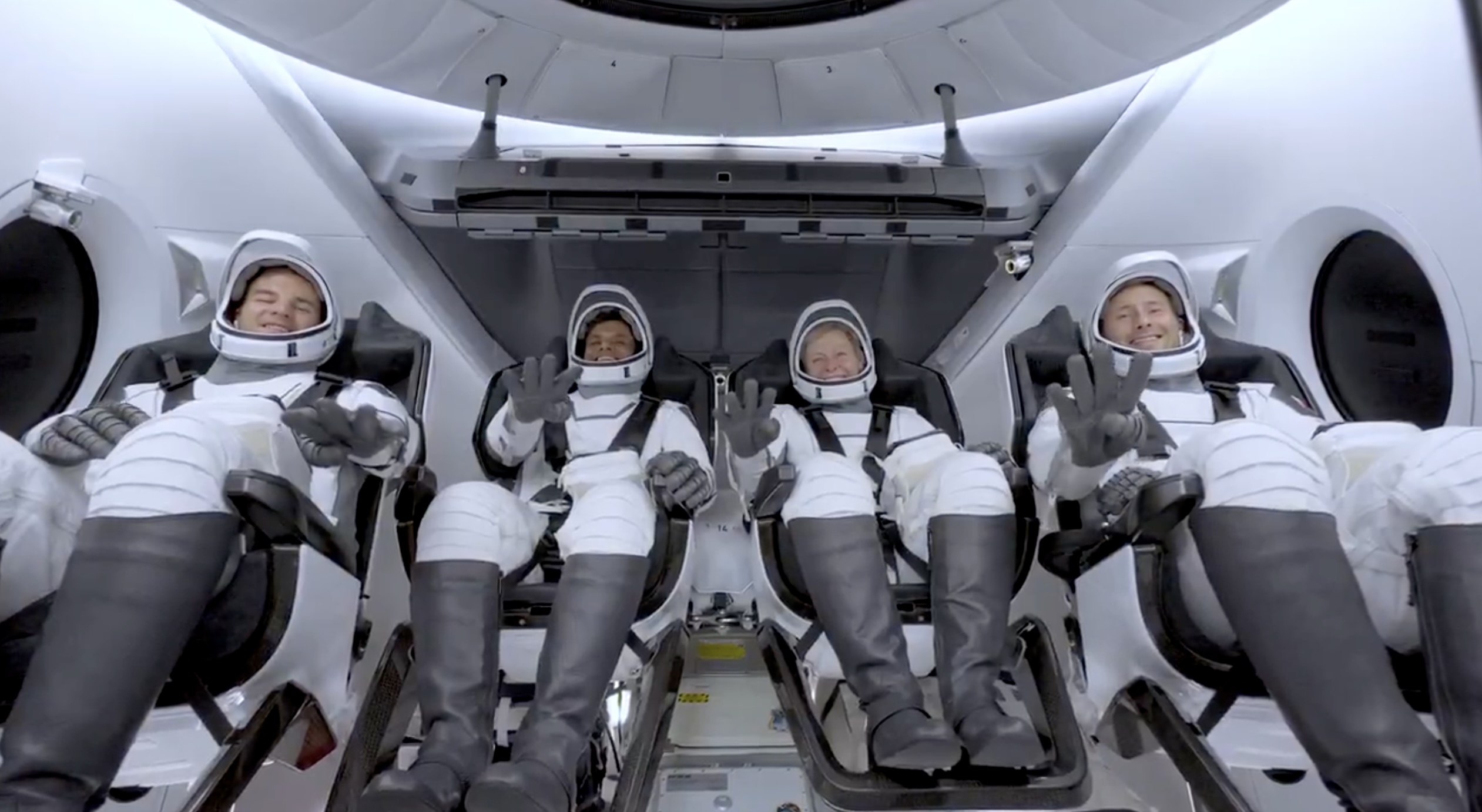
SpaceX launched the Falcon 9 rocket kickstarting Axiom Space’s Ax-4 mission to the International Space Station (ISS). Axiom’s Ax-4 mission is led by a historic international crew and lifted off from Kennedy Space Center’s Launch Complex 39A at 2:31 a.m. ET on June 25, 2025.
The Ax-4 crew is set to dock with the ISS around 7 a.m. ET on Thursday, June 26, 2025. Axiom Space, a Houston-based commercial space company, coordinated the mission with SpaceX for transportation and NASA for ISS access, with support from the European Space Agency and the astronauts’ governments.
The Ax-4 mission marks a milestone in global space collaboration. The Ax-4 crew, commanded by U.S. astronaut Peggy Whitson, includes Shubhanshu Shukla from India as the pilot, alongside mission specialists Sławosz Uznański-Wiśniewski from Poland and Tibor Kapu from Hungary.
“The trip marks the return to human spaceflight for those countries — their first government-sponsored flights in more than 40 years,” Axiom noted.
Shukla’s participation aligns with India’s Gaganyaan program planned for 2027. He is the first Indian astronaut to visit the ISS since Rakesh Sharma in 1984.
Axiom’s Ax-4 mission marks SpaceX’s 18th human spaceflight. The mission employs a Crew Dragon capsule atop a Falcon 9 rocket, designed with a launch escape system and “two-fault tolerant” for enhanced safety. The Axiom mission faced a few delays due to weather, a Falcon 9 leak, and an ISS Zvezda module leak investigation by NASA and Roscosmos before the recent successful launch.
As the crew prepares to execute its scientific objectives, SpaceX’s Ax-4 mission paves the way for a new era of inclusive space research, inspiring future generations and solidifying collaborative ties in the cosmos. During the Ax-4 crew’s 14-day stay in the ISS, the astronauts will conduct nearly 60 experiments.
“We’ll be conducting research that spans biology, material, and physical sciences as well as technology demonstrations,” said Whitson. “We’ll also be engaging with students around the world, sharing our experience and inspiring the next generation of explorers.”
SpaceX’s Ax-4 mission highlights Axiom’s role in advancing commercial spaceflight and fostering international partnerships. The mission strengthens global space exploration efforts by enabling historic spaceflight returns for India, Poland, and Hungary.
News
Starlink Cellular’s T-Mobile service to grow with third-party app data
From Oct 2025, T-Satellite will enable third-party apps in dead zones! WhatsApp, X, AccuWeather + more coming soon.

Starlink Cellular’s T-Mobile service will expand with third-party app data support starting in October, enhancing connectivity in cellular dead zones.
T-Mobile’s T-Satellite, supported by Starlink, launches officially on July 23. Following its launch, T-Mobile’s Starlink Cellular service will enable data access for third-party apps like WhatsApp, X, Google, Apple, AccuWeather, and AllTrails on October 1, 2025.
T-Mobile’s Starlink Cellular is currently in free beta. T-Satellite will add MMS support for Android phones on July 23, with iPhone support to follow. MMS support allows users to send images and audio clips alongside texts. By October, T-Mobile will extend emergency texting to all mobile users with compatible phones, beyond just T-Mobile customers, building on its existing 911 texting capability. The carrier also provides developer tools to help app makers integrate their software with T-Satellite’s data service, with plans to grow the supported app list.
T-Mobile announced these updates during an event celebrating an Ookla award naming it the best U.S. phone network, a remarkable turnaround from its last-place ranking a decade ago.
“We not only dream about going from worst to best, we actually do it. We’re a good two years ahead of Verizon and AT&T, and I believe that lead is going to grow,” said T-Mobile’s Chief Operating Officer Srini Gopalan.
T-Mobile unveiled two promotions for its Starlink Cellular services to attract new subscribers. A free DoorDash DashPass membership, valued at $10/month, will be included with popular plans like Experience Beyond and Experience More, offering reduced delivery and service fees. Meanwhile, the Easy Upgrade promotion targets Verizon customers by paying off their phone balances and providing flagship devices like the iPhone 16, Galaxy S25, or Pixel 9.
T-Mobile’s collaboration with SpaceX’s Starlink Cellular leverages orbiting satellites to deliver connectivity where traditional networks fail, particularly in remote areas. Supporting third-party apps underscores T-Mobile’s commitment to enhancing user experiences through innovative partnerships. As T-Satellite’s capabilities grow, including broader app integration and emergency access, T-Mobile is poised to strengthen its lead in the U.S. wireless market.
By combining Starlink’s satellite technology with strategic promotions, T-Mobile is redefining mobile connectivity. The upcoming third-party app data support and official T-Satellite launch mark a significant step toward seamless communication, positioning T-Mobile as a trailblazer in next-generation wireless services.
News
Starlink expansion into Vietnam targets the healthcare sector
Starlink aims to deliver reliable internet to Vietnam’s remote clinics, enabling telehealth and data sharing.

SpaceX’s Starlink expansion into Vietnam targets its healthcare sector. Through Starlink, SpaceX seeks to drive digital transformation in Vietnam.
On June 18, a SpaceX delegation met with Vietnam’s Ministry of Health (MoH) in Hanoi. SpaceX’s delegation was led by Andrew Matlock, Director of Enterprise Sales, and the discussions focused on enhancing connectivity for hospitals and clinics in Vietnam’s remote areas.
Deputy Minister of Health (MoH) Tran Van Thuan emphasized collaboration between SpaceX and Vietnam. Tran stated: “SpaceX should cooperate with the MoH to ensure all hospitals and clinics in remote areas are connected to the StarLink satellite system and share information, plans, and the issues discussed by members of the MoH. The ministry is also ready to provide information and send staff to work with the corporation.”
The MoH assigned its Department of Science, Technology, and Training to work with SpaceX. Starlink Vietnam will also receive support from Vietnam’s Department of International Cooperation. Starlink Vietnam’s agenda includes improving internet connectivity for remote healthcare facilities, developing digital infrastructure for health examinations and remote consultations, and enhancing operational systems.
Vietnam’s health sector is prioritizing IT and digital transformation, focusing on electronic health records, data centers, and remote medical services. However, challenges persist in deploying IT solutions in remote regions, prompting Vietnam to seek partnerships like SpaceX’s.
SpaceX’s Starlink has a proven track record in healthcare. In Rwanda, its services supported 40 health centers, earning praise for improving operations. Similarly, Starlink enabled remote consultations at the UAE’s Emirati field hospital in Gaza, streamlining communication for complex medical cases. These successes highlight Starlink’s potential to transform Vietnam’s healthcare landscape.
On May 20, SpaceX met with Vietnam’s Ministry of Industry and Trade, announcing a $1.5 billion investment to provide broadband internet, particularly in remote, border, and island areas. The first phase includes building 10-15 ground stations across the country. This infrastructure will support Starlink’s healthcare initiatives by ensuring reliable connectivity.
Starlink’s expansion in Vietnam aligns with the country’s push for digital transformation, as outlined by the MoH. By leveraging its satellite internet expertise, SpaceX aims to bridge connectivity gaps, enabling advanced healthcare services in underserved regions. This collaboration could redefine Vietnam’s healthcare infrastructure, positioning Starlink as a key player in the nation’s digital future.
-

 Elon Musk2 weeks ago
Elon Musk2 weeks agoTesla investors will be shocked by Jim Cramer’s latest assessment
-

 Elon Musk2 days ago
Elon Musk2 days agoxAI launches Grok 4 with new $300/month SuperGrok Heavy subscription
-

 Elon Musk4 days ago
Elon Musk4 days agoElon Musk confirms Grok 4 launch on July 9 with livestream event
-

 News1 week ago
News1 week agoTesla Model 3 ranks as the safest new car in Europe for 2025, per Euro NCAP tests
-

 Elon Musk2 weeks ago
Elon Musk2 weeks agoA Tesla just delivered itself to a customer autonomously, Elon Musk confirms
-

 Elon Musk1 week ago
Elon Musk1 week agoxAI’s Memphis data center receives air permit despite community criticism
-

 News2 weeks ago
News2 weeks agoXiaomi CEO congratulates Tesla on first FSD delivery: “We have to continue learning!”
-

 Elon Musk1 week ago
Elon Musk1 week agoTesla scrambles after Musk sidekick exit, CEO takes over sales

